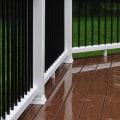The question of how far a deck beam can overhang a post is integral to the design and safety of deck construction, blending engineering principles with building codes to ensure durability and stability. The allowable overhang, or cantilever, of a deck beam over a post depends on several factors, including the type of lumber used, the size of the beam, the span between supports, and the specific load requirements of the deck. Typically, building codes specify a maximum overhang ratio, which is often 1/4 of the span between posts, though this can vary based on local regulations and the design of the deck.
The structural integrity of a deck is paramount, requiring careful consideration of the forces it will bear, including the weight of the deck materials, furniture, people, and the effects of wind and snow. Engineers and architects often turn to guidelines set forth in a home builders magazine, which emphasizes the importance of adhering to local building codes and using proper engineering practices. These resources suggest that the strength and stability of a deck's structure can be significantly enhanced by minimizing the beam overhang. This not only reduces the leverage force at the beam-to-post connection but also decreases the potential for deflection, ensuring a safer and more durable deck.
When planning a deck, one must also consider the type of lumber being used, as different species of wood have varying strengths and load-bearing capacities. Pressure-treated lumber, for instance, is commonly used for deck framing due to its resistance to decay and insects, but even within this category, the specific grade of the wood can affect its load-bearing capabilities. A home builders magazine often highlights the importance of selecting the right materials for the job, advising builders to consult with local lumber suppliers to ensure that the lumber meets the necessary standards for strength and durability.
Moreover, the design of the deck itself plays a crucial role in determining the allowable beam overhang. For decks with a more complex layout or additional features such as hot tubs or outdoor kitchens, the load requirements will be higher, potentially reducing the maximum allowable overhang. In these cases, additional support posts may be necessary to safely distribute the load and prevent overstressing any part of the deck structure.
The connection between the beam and the posts is another critical factor in the stability of a deck. Home builders magazine often features articles on best practices for deck construction, including the use of proper hardware and fasteners to secure the beam to the posts. Metal brackets, screws, and bolts designed for outdoor use can help to ensure a strong, durable connection that can withstand the elements and the load placed on the deck.







